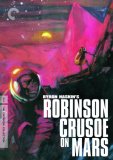| Reviews & Columns |
|
Reviews DVD TV on DVD Blu-ray 4K UHD International DVDs In Theaters Reviews by Studio Video Games Features Collector Series DVDs Easter Egg Database Interviews DVD Talk Radio Feature Articles Columns Anime Talk DVD Savant Horror DVDs The M.O.D. Squad Art House HD Talk Silent DVD
|
DVD Talk Forum |
|
|
| Resources |
|
DVD Price Search Customer Service #'s RCE Info Links |
|
Columns
|
|
|
Robinson Crusoe on Mars - Criterion Collection
The science fiction film had its heyday in the 1950's. The George Pal classic Destination Moon was the film that opened the floodgates with its scientific look at how we could, possibly, get to the moon. People swarmed to it and other SF films throughout the 50's, but soon cheaply made and poorly written movies were flooding the market and pushed out the quality pictures. By the end of the decade the SF film was all but finished. The end of the first golden age of SF films is debatable, but I've always considered 1962's Robinson Crusoe on Mars to be the end point. Like Destination Moon this film went to great lengths to be scientifically accurate and treated the subject matter seriously. This wasn't a poverty row make-a-quick-buck film but a movie that a lot of thought went into. Criterion has, at last, released this classic on DVD with a newly restored image and audio track as well as some great extras this is a SF lover's dream.
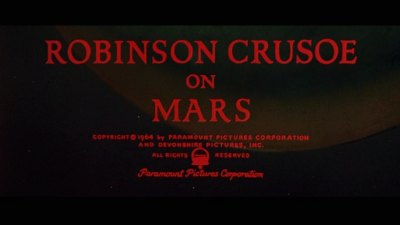
While making a trial flight to the red planet with the intention of landing a monkey on the planet, Mars Gravity Probe I has to make an emergency maneuver in order to avoid a meteor. Getting back into a stable orbit uses up all of their fuel. Unable to leave orbit the ship is abandoned and the only survivors are Commander Kit Draper and the monkey Mona.
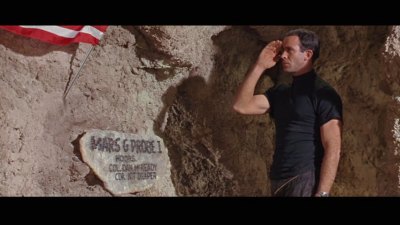 Though he survived the landing, there are many problems that Draper has to solve; a source of oxygen being the most pressing. He also has to find water and food, and when he's done that he finds another problem that the scientists back on Earth hadn't thought of: the crushing loneliness. With no one to talk to and no hope of rescue Draper nearly goes crazy until something happens that makes him forget his isolation and starts him worrying about survival.
Though he survived the landing, there are many problems that Draper has to solve; a source of oxygen being the most pressing. He also has to find water and food, and when he's done that he finds another problem that the scientists back on Earth hadn't thought of: the crushing loneliness. With no one to talk to and no hope of rescue Draper nearly goes crazy until something happens that makes him forget his isolation and starts him worrying about survival.
There's a lot to recommend in this film. The science is pretty accurate, especially when current films still get a lot wrong. The astronauts use retro rockets correctly to changed course, and the idea of employing a landing module while the main spacecraft stays in orbit was adopted by NASA only a year or so before this film was made. They correctly noted that it was hot during the day and freezing at night on Mars too.
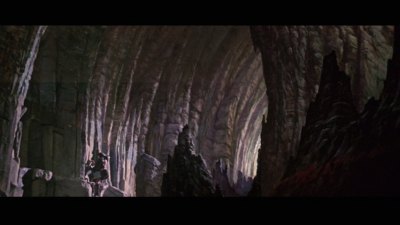 The struggle that Draper goes through battling his isolation was realistic and director Byron Haskin did a good job of compressing time and making the weeks and months pass quickly for the viewer. Haskin, who had a background in special effects (he once headed up that unit at Warner Brothers) made sure that the locations looked like Mars (the exterior scenes were shot in Death Valley) and that the visual effects were well done. The image of the spaceship zooming towards Mars at the beginning was impressive and a great way to start off the film. Haskins also directed War of the Worlds (1953), Conquest of Space (1955), and From the Earth to the Moon (1958) so he knew his way around a science-fiction movie set.
The struggle that Draper goes through battling his isolation was realistic and director Byron Haskin did a good job of compressing time and making the weeks and months pass quickly for the viewer. Haskin, who had a background in special effects (he once headed up that unit at Warner Brothers) made sure that the locations looked like Mars (the exterior scenes were shot in Death Valley) and that the visual effects were well done. The image of the spaceship zooming towards Mars at the beginning was impressive and a great way to start off the film. Haskins also directed War of the Worlds (1953), Conquest of Space (1955), and From the Earth to the Moon (1958) so he knew his way around a science-fiction movie set.
The problems with the film mainly derive from the script. The film was the brainchild of Ib Melchior who had also written several SF scripts, but his pedigree wasn't nearly as impressive as Haskins. Melchior wrote the mediocre Angry Red Planet (1960), the horrible Reptilicus (1961) (though the blame for the film can't all be laid at his feet), and Journey to the Seventh Planet (1962). Adapting Daniel Defoe's novel to the planet Mars was an interesting idea, but as it was filmed (the script was tweaked by John C. Higgins, which is an unusual choice since he mainly wrote noir thrillers) it didn't come off as well as it could. The pace is rather slow throughout the film's nearly two hour length, but given the nature of the story that can be forgiven. The multiple last-minute saves and amazing coincidences get to be a little hard to swallow however. The worst offense is the third act however. After taking great pains to create a (semi-) scientifically accurate film they throw that out the window by having aliens appear.
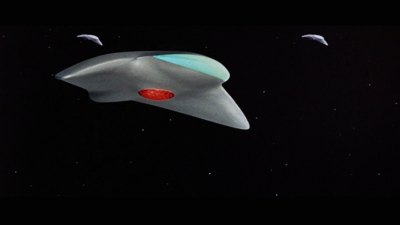 Haskins made some unusual choices for the film too. The aliens wear left over costumes from Destination Moon, but that can be chalked up to money saving measures, and they're not on screen for that long. The alien ships are another matter however. They are copies of the Martian vehicles from The War of the Worlds. No, they didn't reuse the old props instead (according to the liner notes) Haskins commissioned new ships to be built based on the old models.
Haskins made some unusual choices for the film too. The aliens wear left over costumes from Destination Moon, but that can be chalked up to money saving measures, and they're not on screen for that long. The alien ships are another matter however. They are copies of the Martian vehicles from The War of the Worlds. No, they didn't reuse the old props instead (according to the liner notes) Haskins commissioned new ships to be built based on the old models.
Mantee does a very good job in the film, especially since he didn't have anyone to act off of for a majority of the running time. He manages to convey his character's loneliness however and does it quite effectively.
The DVD:
Audio:
The mono audio track has been cleaned up nicely and sounds good. There is no hiss or background noise and though the range isn't as wide as a recent release, it is acceptable. The dialog is nice and clear and there was only one instance where the audio cracked (when the 'alarm clock' was going off) though it may have been recorded like that.
Video:
The restored image looks great, especially for a film that's 40 years old. Presented with its original aspect ratio of 2.35:1 and anamorphically enhanced, the colors were very vivid and the level of detail was excellent. The main flaw with the image was that there's a fair amount of digital noise. This is most evident in the sky shots and large Death Valley (where the film was shot) vistas. Aliasing, blocking, and other common compression artifacts are not present.
Extras:
As one would expect from top price tier discs, there are a good number of extras on this disc. First is a commentary track with writer Ib Melchior, actors Paul mantee and Victor Lundin, production designer Al Nozaki, and film historian Robert Skotak. These were recorded separately in 1994 and cut together along with a 1979 interview with director Byron Haskin. It actually plays much better than you'd think, with the various participants discussing the filming and creation of the movie. There's a lot of interesting anecdotes and this track is well worth listening to.
There's also a newly created featurette; Destination: Mars. This 20-minute bonus discusses the science in the film and how much they actually got right. Criterion also turned Victor Lundin's song "Robinson Crusoe on Mars" into a music video using clips from the film and includes that too. The disc is rounded out with a theatrical trailer, a gallery of promotional items and production art, and excerpts from the script. All in all a nice selection of material that complements the film very well.
There is also a booklet insert that contains a six page essay by writer-director Michael Lennick, a list of chapter stops, facts about Mars, and a Yargorian dictionary (for those who are having too much trouble mastering Klingon.)
Final Thoughts:
While this isn't a perfect film it is very good. It was one of the last SF films that took the genre seriously and was the end of the boom of the 50's. Fans would have to wait four long years until 2001 was released to find another solid SF film. This Criterion disc presents the film with a set of wonderful extras and a gorgeous transfer. Recommended.
|
| Popular Reviews |
| Sponsored Links |
|
|
| Sponsored Links |
|
|
| Release List | Reviews | Shop | Newsletter | Forum | DVD Giveaways | Blu-Ray | Advertise |
|
Copyright 2024 DVDTalk.com All Rights Reserved. Legal Info, Privacy Policy, Terms of Use,
Manage Preferences,
Your Privacy Choices | |||||||









